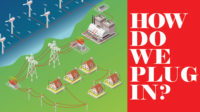Clean Energy
California To Be Key Buyer of Floating Offshore Wind Energy
.png?1695914651)
Ocean Infinity will deploy multiple autonomous underwater vehicles (AUVs) from a single vessel to collect subsea data for design and construction of the Equinor floating offshore wind energy site off Morro Bay, Calif.
Photo: Ocean Infinity
As Norwegian energy giant Equinor moves ahead to build one of the first floating offshore wind projects in the U.S, it has awarded a contract to marine robotics firm Ocean Infinity to survey the 80-acre site in deep water off the coast of Morro Bay, Calif.
The firm made the winning $130-million bid for the site last December, at the first-ever federal offshore wind lease sale in U.S. deep water, which requires use of floating technology for wind turbine installation. Deepwater sites off the Maine coast also are being considered for wind energy research and development.
Equinor has operated since 2017 the 30-MW Hywind project, the world's first floating wind farm, in 120-m-deep water off Scotland.
Under the agreement, the value of which was not disclosed, Ocean Infinity will deploy multiple autonomous underwater vehicles (AUVs) from a single vessel to collect subsea data at the Equinor site. The firm is based in Austin, Texas and Southampton, England.
The project start comes amid some development bumps for the U.S. offshore wind energy sector.
California has set a goal to generate two to five gigawatts of offshore wind by 2030 and 25 GW by 2045, says the California Energy Commission. But developers face the challenge of building more complex floating turbines and added transmission and port staging infrastructure in Morro Bay and offshore of Humboldt County, where a project lease also was awarded.
State to Be Offshore Wind Buyer
In a move to boost jumpstart development, California lawmakers passed legislation earlier this month to allow the state to buy uncontracted energy from offshore sites. Set to be signed by Gov. Gavin Newsom, it authorizes the state Dept. of Water Resources to sell the power to utility companies and customers under a plan called "central procurement."
The bill calls on state regulators to “assess barriers” to power interconnection and recommend how to “accelerate those processes.”
Chris Hannan, president of the state Building and Construction Trades Council, said the legislation “demonstrates California’s continued commitment to our environment, stabilization of our energy grid and support of the local skilled and trained construction workforce.”
Molly Croll, director of Pacific offshore wind at clean energy trade group American Clean Power, said the strategy “doesn’t provide complete market certainty — but it provides much more market clarity than we had before,” according to a Sept. 27 report in Canary Media.
The Equinor survey would begin in February, with AUVs providing data for Equinor to use for site assessment, project design and a construction and operations plan need for federal project approval. The company said its lease area could generate a total capacity of at least 2 GW.
"AUVs in scale are the perfect tool for this region providing not only great data quality advantages over towed arrays, in water depths spanning from 974 to 1,317 meters (about 4,507 feet), but also huge efficiency over wide areas,” said an Ocean Infinity spokesman.
The firm previously won a contract from ExxonMobil to deploy AUVs in the Stabroek oil field off the coast of Guyana.
New Infrastructure Eyed
Even though the central California coast offers ports at Morro Bay and Port San Luis, they are only equipped to provide operation and maintenance support for offshore wind energy, according to a recent U.S. Interior Dept. report. The nearest ports with the capability to also support manufacturing are in the Los Angeles-Long Beach area to the south and Redwood City to the north.
Weighing in this month on port expansion is an analysis by the National Renewable Energy Laboratory focused on the needs of the west coast.
“It could take an investment of around $5 billion to $10 billion to develop the installation and maintenance ports needed to build and operate 25 to 55 gigawatts of floating offshore wind on the West Coast and at least another $10 billion to build manufacturing ports to support a local supply chain,” said Matt Shields, an agency energy analyst who led the study. “If we don't make these investments, then this huge opportunity is at risk of not developing at all."
Infrastructure consultant Moffat & Nichol and the U.S. Energy Dept supported the study, funded through the 2021 infrastructure investment law.
The Business Network for Offshore Wind, the leading U.S. offshore wind market advocacy group, also outlined in a new report, a $36-billion plan for overall U.S. port infrastructure needs—including public and private investment, as well as new state and federal policy—to help reach Biden administration deployment targets for all U.S offshore wind of 30 GW by 2030 and 110 GW by 2050.




